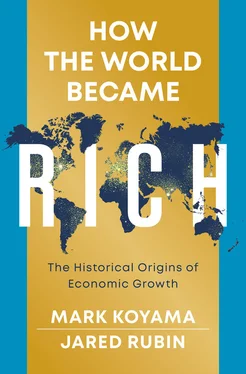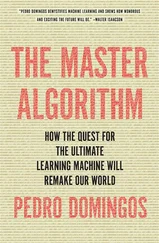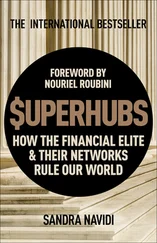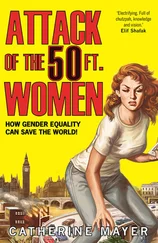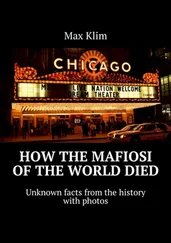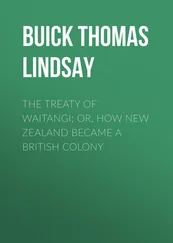The answer to the question “How did the world become rich?” must explain where, when, and how human societies were able to achieve sustained economic growth. The where and the when we know the answer to: northwestern Europe and North America, in the early to mid-19th century. All of the metrics we discussed above agree on this point. It is the third question – how did the escape from stagnation happen – that is so vexing.
Understanding the origins of wealth is one of the most important pursuits of the social sciences, and for this reason it has been the center of much debate. The purpose of this book is to present and distill this debate. Ultimately, any credible hypothesis must be able to account for a number of facts. First, modern, sustained economic growth is the result of sustained technological innovation. Britain in the late 18th century experienced such a spate of innovations during the period known as the Industrial Revolution. Initially, economic growth was slow to follow. But unlike earlier episodes of economic growth, it did not peter out. By the mid-19th century, the rate of both innovation and economic growth accelerated as industrialization and structural economic change spread to other parts of the world. Why did this process first take hold in Britain? Why in the 18th century? Why not in some other part of the world? Second, Europe was an economic, technological, and cultural backwater around 1000 CE. What changed in that continent that allowed it to pull ahead of China, India, and the Middle East, all of which at one point had societies well ahead of even the most advanced societies in Western Europe?
What Will You Learn from This Book?
The goal of this book is to bring together the many social scientific theories on the origins of modern, sustained economic growth. This is a big issue with important implications, and unsurprisingly it has been the focus of many great minds. Almost all of these theories focus on one aspect of the origins of growth, such as geography, culture, institutions, colonialism, or demography. By construction, these arguments tend to ignore each other. We hardly fault the authors of the arguments for this. Building and substantiating a theory can take hundreds of pages. Delving into other, far-removed causes of long-run growth can make for a tough read. Most researchers understand this, and they understand the limits of their explanations. Many a successful career has been made by exploring just one aspect of the origins of modern wealth.
Yet, the emphasis on specific theories of “how the world became rich” has left two gaps in our knowledge. This book hopes to fill these. First, no existing work summarizes all of the advances that have been made by social scientists in the last few decades in a dispassionate, objective fashion. While we do have opinions on what we view as the most convincing hypotheses regarding the origins of sustained economic growth – we have both written on this topic in our own academic work – the goal of this book is not to privilege our preferred theories at the expense of others. The first half of this book simply presents, as objectively as possible, the major hypotheses and debates on the origins of sustained economic growth. If it were not for our book, a reader who wants to get an idea of the current state of the literature would have to read countless books and articles, each putting forth their own hypotheses. This is still a useful exercise, as there is much nuance that we will have to skip over. But presumably most of our readers have lives outside of reading academic tracts. If you want to get an idea of where the debates stand, we’ve done the time-consuming part for you.
The first half of the book classifies and surveys the major strands of literature related to the origins of sustained economic growth: geography, politics, institutions, markets and states, culture, human capital, demography, and colonization. Many explanations fall into multiple categories. Likewise, some are well suited for one time and place but not for others. For instance, coal deposits likely played a role in Britain’s rise but not Japan’s, religion may have played a role in the Middle East’s economic growth but not in China’s, and so on. In some cases, factors that hamper economic growth under some conditions favor it in others. Take, for instance, the ruggedness of the African terrain. In general, ruggedness is bad for prosperity. Rugged terrain is difficult to traverse (thus hampering trade) and difficult to farm. However, in Africa, Nunn and Puga (2012) find that ruggedness had a positive effect on income. This was because it mitigated the impact of the slave trade: rugged terrain was more difficult for raiders to traverse and easier for those pursued to hide within. Long-run economic growth, on which the slave trade had such a large negative effect (a fact we will cover in Chapter 6), was thus indirectly promoted (see Figure 1.7).
Most theories on the origins of economic growth are concerned with pushing one side of the debate. As a result, less attention has been given to how the various theories are connected . A phenomenon as important and widespread as the origin of modern economic growth is almost certainly not monocausal. For example, many theories attempt to account for the role that institutions played in economic growth. Institutions are those legal, political, and religious features of a society that determine the “rules of the game” which dictate the costs and benefits of taking certain actions. Some institutions are viewed as being good for economic growth, such as those that protect property rights, encourage investment in public goods, and apply laws equally to all people. Yet, where “good institutions” come from is a difficult question to answer. Sometimes, they come from geographic conditions. For instance, where geographic conditions were not suitable for exploitation, colonial powers tended to invest in institutional development that, perhaps for unintended reasons, had positive effects on long-run growth (Acemoglu, Johnson, and Robinson, 2001, 2002). In fact, Acemoglu, Johnson, and Robinson (2002) argue that this resulted in a “reversal of fortunes”: those places that were flush with natural endowments at the end of the medieval period were also the places that were most easily exploited. As a result, those places tended to get worse (colonial) institutions, and are largely poorer today. The reversal is seen in Figure 1.8, which plots urbanization rates (an indicator of economic potential) against modern per capita GDP. Past urbanization rates are negatively correlated with modern income, while modern urbanization rates are positively correlated with income. Geography alone cannot explain this pattern, although geography may have worked through institutions to create the reversal of fortunes.
In other cases, institutions may operate through their impact on culture to affect economic growth. For instance, in a study of the long-term developments of trust, Nunn and Wantchekon (2011) find that places in Africa that were more prone to slave raids in the past are less trusting in the present day . It is understandable why people in the past who were subject to slave raids would be mistrusting of others, even neighbors, who may have wanted to enslave them. The fact that a culture of mistrust persists to the present suggests that culture is “sticky,” and thus helps determine long-run economic fortunes.
Throughout the book, we draw on the most up-to-date social scientific research and data in the context of recent debates among economic historians, development economists, political scientists, and historical sociologists. One important development in the past twenty years is that discussions of the origins of economic growth have gone global. It is no longer sufficient to narrow one’s attention to Great Britain or Western Europe. For instance, one of the biggest debates in the literature is on the origins of the “Great Divergence” between Western Europe and China. The term “Great Divergence” was made famous by Pomeranz (2000), who argued that the divergence between China and the West happened relatively late (after 1750) and was a result of the existence of coal reserves in England and the opening up of the New World, which relieved population pressures and provided new and abundant raw materials. This view has been subject to much debate, with new data suggesting the divergence may have occurred prior to industrialization (Allen, Bassino, Ma, Moll-Murata, and van Zanden, 2011; Brandt, Ma, and Rawski, 2014; Broadberry, Guan, and Li, 2018).
Читать дальше
